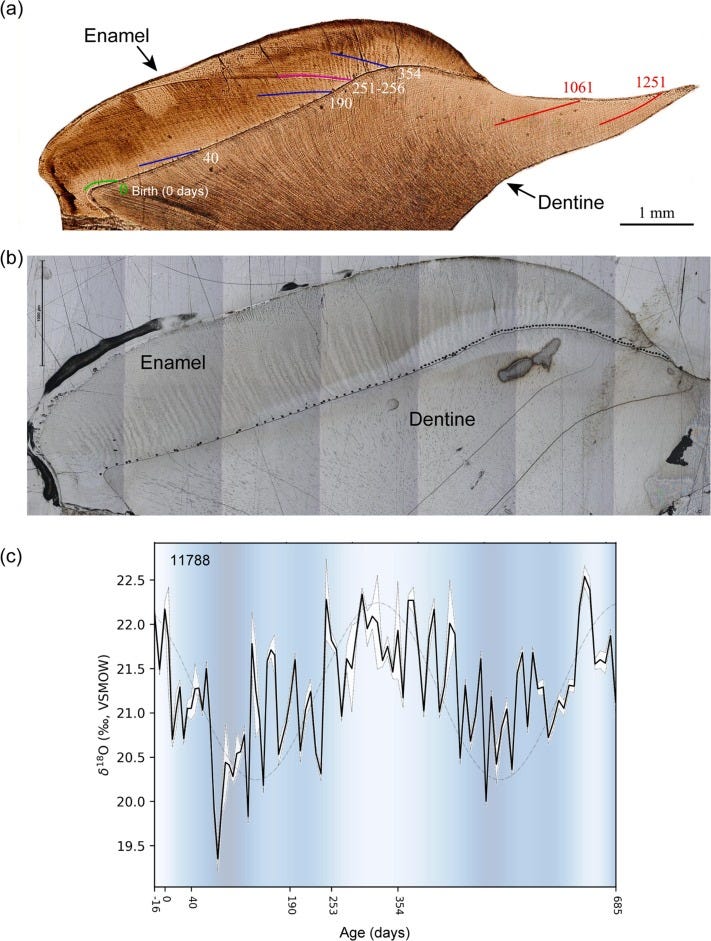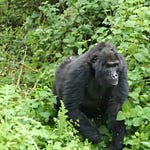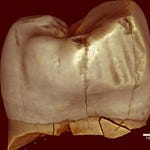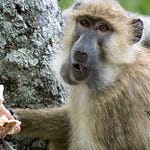Rainfall in a Tooth
Primate teeth are more than tools for chewing. They are miniature archives, layered in enamel and dentin, that silently track the chemistry of what a body consumes day after day. Now, a team of researchers has shown that these mineral structures don’t just record diet—they also capture climate.
In a study published in Geochimica et Cosmochimica Acta1, scientists used high-resolution isotopic analysis to trace seasonal rainfall patterns and water stress from the enamel of 17 molars belonging to 14 individuals, including chimpanzees, macaques, and one human. The results show that tooth enamel faithfully reflects shifts in drinking water composition, even pinpointing episodes of dehydration and storm-driven rainfall.

The implications stretch far beyond the tooth itself. These techniques offer a way to reconstruct ancient weather, water access, and ecological pressures that shaped the lives—and possibly the migrations—of extinct hominins.
Daily Diaries in Enamel
Teeth grow in daily increments, and those tiny layers lock in chemical signals from what an animal consumes. One such signal is the stable oxygen isotope oxygen-18 (¹⁸O), which fluctuates based on the temperature, rainfall, and evaporation of the water an individual drinks.
"From both a biological and archaeological perspective, teeth are the strongest part of the human body," said Edgar Huerta, a co-author and PhD candidate at UC Davis. "They preserve really well, but also teeth have a 24-hour formation process that starts before someone is born and lasts until you're about 18 years old."
To measure these isotopes, the team applied Secondary Ion Mass Spectrometry (SIMS), a technique that uses a focused beam of ions to vaporize tiny patches of enamel. The scale of analysis is impressively fine: one data point can represent as little as a week of growth. In total, the researchers generated more than 1,200 measurements from the teeth of wild chimpanzees, captive macaques, and a modern human born in 1990 in Brisbane, Australia.
A Tooth in Brisbane, a Cyclone in the Record
The human molar offered a clear test case. The enamel of the Brisbane donor began forming during a summer marked by intense rainfall and cyclonic activity in Queensland. The tooth’s oxygen-18 levels dropped in step with the rains.
"Her tooth enamel formed during the summer of 1990 showed oxygen isotope trends that were consistent with the rainfall patterns at the time," said lead author Tanya Smith of Griffith University. "The minimum values occurred close in time to the wettest period, and the maximum values happened towards the end of the long dry spell that began later in the year."
For the captive macaques, isotopic shifts reflected more personal conditions—such as illness or dehydration. In the wild chimpanzees, patterns of isotope fluctuation mirrored broader seasonal variation, offering a rough calendar of wet and dry seasons encoded in enamel.
Past Methods, Present Precision
Earlier approaches to isotope analysis often involved bulk sampling. Teeth would be sliced into sections spanning months of growth. The SIMS method allows researchers to zoom in on week-to-week variation, offering a much finer temporal resolution.
"Previously, we'd cut a tooth into small sections using a saw," said co-author Jelmer Eerkens of UC Davis. "This would give us data points with an interval of about 3–6 months. The SIMS technique uses a highly focused ion beam... which gets us down to about a week of growth."
This granularity is crucial for reconstructing short-term changes, such as sudden droughts, illness, or environmental shifts that may have triggered behavioral responses in past populations.
Ancient Implications
While the oldest individual studied was born in 1990, the methods can be extended to fossil teeth from extinct primates and hominins. If those teeth preserve enamel well enough, SIMS could allow paleoanthropologists to detect ancient climate variability at a scale that matches individual experience—rather than just long-term environmental averages.
"There are a lot of questions surrounding when modern humans left Africa and what conditions they were experiencing during that time," Huerta noted. "We would like to see this technique applied to those paleontological questions."
Migration, dietary change, even shifts in weaning age or drought adaptation could be explored in detail with this approach. If paired with other paleoenvironmental records, enamel isotope mapping may offer a bottom-up perspective on how ancient individuals coped with the climates they inhabited.
Teeth as Tools for Paleoecology
This research highlights a broader trend in anthropology and paleoclimatology: the recognition that biological tissues are repositories of environmental information. Just as tree rings tell stories of drought and fire, tooth enamel can tell stories of rain, thirst, and seasonal shifts.
This is especially valuable in regions where traditional climate proxies are scarce or poorly preserved. Fossil teeth are common in archaeological and paleontological assemblages. With the right tools, each one could serve as a miniature climate sensor, offering insight into how primates—including hominins—navigated changing landscapes over time.
Related Research and Further Reading
Leichliter, J. N., et al. (2022). Oxygen isotope analysis of tooth enamel reveals seasonal dietary shifts in early Pleistocene hominins. Nature Ecology & Evolution, 6(3), 327–334. https://doi.org/10.1038/s41559-021-01617-6
Blumenthal, S. A., et al. (2017). Aridity and hominin environments. PNAS, 114(28), 7331–7336. https://doi.org/10.1073/pnas.1705481114
Smith, T. M., & Tafforeau, P. (2013). New approaches to tooth growth and structure in human evolution. Journal of Human Evolution, 64(6), 452–464. https://doi.org/10.1016/j.jhevol.2013.02.006
Burgess, C. P., et al. (2023). Drinking histories from fossil apes to modern humans: enamel isotopes and the ecology of hydration. Evolutionary Anthropology, 32(4), 167–180. https://doi.org/10.1002/evan.21937
Smith, T. M., Ávila, J. N., Eerkens, J. W., Green, D. R., Hinde, K., Huerta, E., Tafforeau, P., & Williams, I. S. (2025). Primate teeth are good proxies for understanding past water inputs and seasonality. Geochimica et Cosmochimica Acta, 402, 200–216. https://doi.org/10.1016/j.gca.2025.05.033









